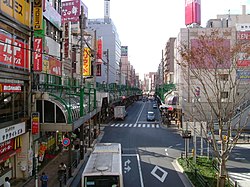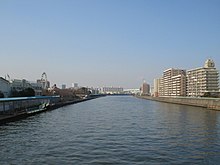Adachi(Đủ lập khu,Adachi-ku)is aspecial wardin theTokyo MetropolisinJapan.It is located to the north of the heart of Tokyo. The ward consists of two separate areas: a small strip of land between theSumida RiverandArakawa Riverand a larger area north of the Arakawa River. The ward is bordered by the cities ofKawaguchi,SōkaandYashioinSaitamaandKatsushika,Sumida,ArakawaandKitain Tokyo. The ward is calledAdachi Cityin English.
Adachi
Đủ lập khu | |
|---|---|
| Adachi City | |
 A street in front of Kita-Senju Station in Adachi | |
 Location of Adachi inTokyo Metropolis | |
| Coordinates:35°47′N139°48′E/ 35.783°N 139.800°E | |
| Country | Japan |
| Region | Kantō |
| Prefecture | Tokyo Metropolis |
| First official recorded | 826 AD |
| As merged with Tokyo City | October 1, 1932 |
| As special ward became to Tokyo | July 1, 1943 |
| Government | |
| • Mayor | Yayoi Kondo (since June 2007) |
| Area | |
• Total | 53.25 km2(20.56 sq mi) |
| Population (October 1, 2020[1]) | |
• Total | 695,043 |
| • Density | 13,052/km2(33,800/sq mi) |
| Time zone | UTC+09:00(JST) |
| City hall address | Chūōhonchō 1-17-1, Adachi-ku, Tokyo 120-8510 |
| Website | www |
| Symbols | |
| Flower | Tulip |
| Tree | Cherry Blossom |


As of May 1, 2015, the ward has an estimatedpopulationof 692,707 and apopulation densityof 13,010 persons per km2.The total area is 53.25 km2.
The Adachi Land Transportation Office is located here, and automobiles registered at this office bear Adachinumber plates.
History
editUnder theRitsuryōsystem, the present-day ward was the southern extremity of Adachi District,Musashi Province.In 826, during theHeian period,the Nishiarai Daishi temple was founded. During theMuromachi periodand into theSengoku period,theChiba clanheld control of the region. The Great Senju Bridge was built in 1594. In theEdo period,parts were under the direct control of theTokugawa shogunate,and parts were under the administration ofKan'ei-ji,a temple in present-dayUeno, Tokyo.Adachi was also home to Senju-shuku was apost stationon both theNikkō Kaidōand theMito Kaidō.The shogunate maintained theKozukappara execution groundsin Senju.
In 1932, Adachi, formerly known asMinamiadachi District,became a ward ofTokyo City.The special ward was founded on March 15, 1947.
Districts and neighborhoods
edit
|
|
|
Sights
editNishiarai Daishi
editNishiarai Daishi, located in Nishiarai, is a temple of theBuzanbranch ofShingon Buddhism.Its formal name is Gochisan Henjōin Sōji-ji (Sōji-ji Temple). This is one of the Three Great Temples[citation needed]in theKantō regionalong withKawasaki Daishiand Sano Yakuyoke Daishi, and a large number of people annually visit the temple atNew Year.
Parks
edit- Toneri Park:
Toneri Park is a metropolitan park located in Toneri. It is divided into east and west sections by Ogubashi Street. The west site has sports facilities such as an athletic stadium, tennis courts and baseball grounds. The east site has a big pond, water park and bird sanctuary. A part of the east site is now under construction. The park can be accessed by arriving atToneri-kōen Stationon theNippori-Toneri Lineror by bus.
- Higashi Ayase Park:
Higashi Ayase Park is a metropolitan park that straddles the border between Ayase and Higashi Ayase. It contains Tokyo Budokan. Within the park, there is aJapanese gardenwhich has a wide variety of plants. It also has sports facilities such as baseball and gateball grounds.
- Urban Agricultural Park:
Urban Agricultural Park (Toshi Nōgyō Kōen), located in Shikahama, is run by Adachi Ward. Officially, it is a part of Kōhoku Park. It is located near the meeting of the Shiba and Arakawa Rivers, and its south end faces a green space on the Arakawa river area. There are fields, orchards, greenhouses and other facilities that aim to show farming techniques that have been adopted in the suburbs of Tokyo. There are also facilities for families such as lawns and play equipment.
There is a rest house near the entrance on the Arakawa riverbank side. The rest house is at the point where the Arakawa and Shibakawa cycling roads meet. There is no admission fee. It is closed early in the morning and late at night, as well as all day on some days such as the year-end and new-year holidays. The park is far from the train station, but there is a bus running fromNishiarai Stationto the park. The park is about a five-minute walk south of the bus stop Shikahama 5 on Kawaguchi Station line (Shikahama-Ryōke) and Akabane Station line (to Nishiarai Station by way of Arakawa Bridge). There is parking for cars and sightseeing buses under the Shuto Expressway Kawaguchi Route, and Shikahamabashi Exit and Higashi Ryōke Exit are nearby. The parking lot is also close to Kan-nana Road.
- Adachi Park of Living Things:
Adachi Park of Living Things, located within Motofuchie Park in Hokima, is run by Adachi Ward.
Halls and cultural facilities
edit- Tokyo Budokan:
Tokyo Budokan, located within Higashi Ayase Metropolitan Park, is a sports facility run by Tokyo Sport Benefits Corporation. The Tokyo Budokan has an avant-garde building designed by a famous architect Kijō Rokkaku. It includes places for martial arts andKyūdō,and training rooms. The wordbudokanmeans "martial arts hall", and the same word is part of the name of the more-famousNippon Budokan.The Tokyo Budokan's address is 3-20-1 Ayase, Adachi, Tokyo.
- Galaxy+City:
Galaxy+City (Gyarakushitii) is a generic term for series of cultural facilities in Kurihara. It used to be run by Adachi Lifelong Educational Promotion Corporation, but the management was taken over by Youth Centre of Adachi Board of Education on April 1, 2005. It contains two main facilities: Nishiarai Culture Hall (theatre) and Adachi Children's Science Museum. There are also event halls, cafes and others.
- Theatre 1010:
Theatre 1010 was named as it is because the number 1010 (Senjū) and the name of the theater's location (Senju) are homonyms in Japanese.
- Adachi Historical Museum:
Adachi Historical Museum, located within Higashifuchie Park in Ōyata, is run by Adachi Ward.
Education
editThe city's public high schools are operated by theTokyo Metropolitan Government Board of Education.
The city's public elementary and junior high schools are operated by the Adachi City Board of Education ( đủ lập khu giáo dục ủy ban ).[2]
International schools:
- Tokyo Korean 4th Elementary and Junior High School(Đông Kinh Triều Tiên đệ tứ sơ trung cấp trường học)-North Korean school[3]
Tokyo Future Universityis located in the area.
Sister cities
editAdachi has sister-city relationships withBelmont,Australia.Within Japan, Adachi has similar ties with the city ofUonuma(formerly the town ofKoide) inNiigata Prefecture,YamanouchiinNagano Prefecture,and the city ofKanumainTochigi Prefecture.
Transportation
editRail
editThe primary railway station in the city isKita-Senju Station.
- ■JR East
- ■Jōban Line-Kita-Senju-Ayase
- ■Tobu Railway
- ■Skytree Line-Horikiri-Ushida- Kita-Senju -Kosuge-Gotanno-Umejima-Nishiarai-Takenotsuka-
- ■Daishi LineNishiarai -Daishimae
- ■Keisei Electric Railway
- ■Keisei Main Line-Senju-Ōhashi-Keisei Sekiya-
- ■Tokyo Metro
- ○Hibiya Line- Kita-Senju
- ○Chiyoda Line- Kita-Senju - Ayase -Kita-Ayase
- ■Metropolitan Intercity Railway Company
- ■Tsukuba Express- Kita-Senju -Aoi-Rokuchō-
- ■Tokyo Metropolitan Bureau of Transportation
- ■Nippori-Toneri Liner-Adachi-Odai-Ōgi-ōhashi-Kōya-Kōhoku-Nishiaraidaishi-nishi-Yazaike-Toneri-kōen-Toneri-Minumadai-shinsuikōen
Highways
edit- No.6 Misato Route (Kosuge JCT - Misato JCT)
- C2 Central Loop (Itabashi JCT - Kasai JCT)
- S1 Kawaguchi Route (Kōhoku JCT - Kawaguchi JCT)
Notable people
edit- Mika Akino,professional wrestler
- Atsuko Asano,actress
- Back-On,rock band
- Tochiazuma Daisuke,sumo wrestler
- Kouta Hirano,manga artist
- Susumu Hirasawa,progressive-electronic musician
- Itsuki Hirata,mixed martial artist
- Kazuki Hirata,professional wrestler
- Jo Kamisaku, murderer ofJunko Furuta
- Kaela Kimura,singer and model
- Takeshi Kitano,comedian and filmmaker
- Daijiro Morohoshi,manga artist
- Nujabes,hip hop artist/producer
- Mayumi Ogawa,actress
- Masatoshi Ono,rock/heavy metal singer
- Tetsuya Naito,professional wrestler
- Tatsuki Seko,soccer player
- Tetsuya Shimizu,professional wrestler
- Daiki Sugioka,soccer player
- Yoshiko Tanaka,actress
- Kyohei Wada,professional wrestling referee
- Kenta Yamazaki,soccer player
References
edit- ^"Population by District".Tokyo Statistical Yearbook.RetrievedJuly 15,2022.
- ^"Đủ lập khu giáo dục ủy ban".city.adachi.tokyo.jp.Archived fromthe originalon December 1, 2005.
- ^ウリハッキョ một lãm.Chongryon.Archivedfrom the original on July 26, 2015.RetrievedOctober 14,2015.()
External links
edit- Adachi City Official Website(in Japanese)


